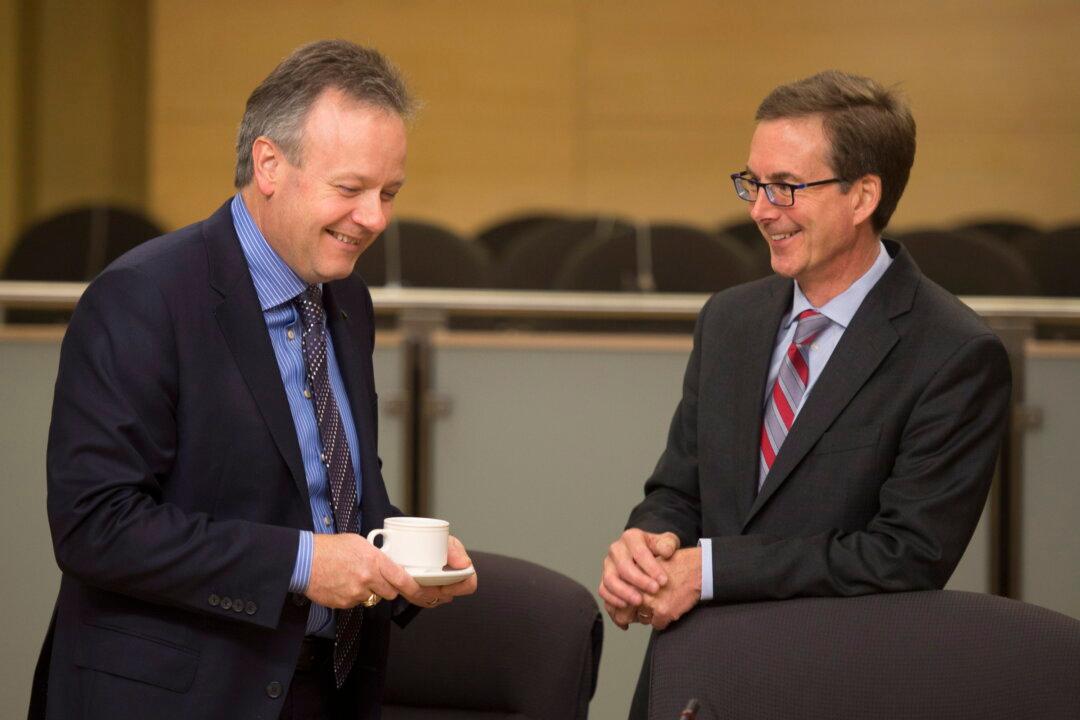TORONTO—Bank of Canada governor Stephen Poloz said Wednesday he disagrees with an assessment that interest rates will have to be raised by the end of 2014.
Poloz and senior deputy governor Tiff Macklem appeared before the Senate Standing Committee on Banking, Trade and Commerce on Wednesday afternoon.
In remarks released after markets closed, Poloz said he disagreed with an assessment Tuesday by the Paris-based Organization for Economic Co-operation and Development (OECD) that the Bank of Canada would have to start raising interest rates by the end of next year. The OECD also cut its 2014 forecast for global growth to 3.6 percent from 4 percent.
The central banker said that while he respects the view of the OECD, different forecasting organizations can use different approaches to predict future economic growth.
Poloz said the Bank of Canada’s thinking on the issue is based on its own view of slack in the Canadian economy and the fact that inflation, at 1.1 percent, is currently well below where he would like it to be.
Last month, Poloz surprised markets by dropping the central bank’s official tightening bias and moved to a more neutral stance, which signals that the bank is as likely to cut as to raise interest rates in the future.
Analysts interpreted the move as the bank telling markets it won’t likely start raising borrowing costs until the first or second quarter of 2015.
Meanwhile, the U.S. central bank released minutes from its latest meeting late last month and they failed to provide any increased reassurances that the Fed won’t soon start to withdraw economic stimulus.
The central bank’s monthly purchase of US$85 billion of bonds have kept long-term rates low and pushed investors into riskier but potentially higher yielding assets such as stocks. The quantitative easing has underpinned substantial gains on many markets this year but left investors on edge for signs the central bank will start reducing its asset purchases.
Janet Yellen, who is slated to become the next Fed chairman, has already expressed strong support for low interest rate and bond buying policies aimed at stimulating U.S. growth.
The U.S. Commerce Department says retail sales rose 0.4 percent in October, impacted by a steep drop in gas prices. Excluding sales at gas stations, retail spending increased an even stronger 0.5 percent.
U.S. home sales data for October came in a bit below expectations. Home resales fell 3.2 percent last month from September to a seasonally adjusted annual pace of 5.12 million versus expectations of 5.16 million because of higher mortgage rates and the U.S. government’s fiscal impasse.
Canada-US Retail Price Gap
In a speech to Mount Allison University in New Brunswick on Tuesday, Bank of Canada’s deputy governor John Murray said the Canada-U.S. retail price gap appears to defy exchange rate movements that have of late brought the loonie to near parity with the U.S. dollar.
But Murray says that is not evidence of a market failure—although it is not perfect—nor does it say that given enough time the price gap does not close as currencies gravitate toward parity. It just takes time for the adjustment to become apparent.
“Despite the large and persistent price gaps that are frequently observed between Canadian and foreign prices at the aggregate level, more detailed work suggests that deviations from the law of one price and purchasing power parity are not as large or as persistent as many believe,” he said.
“While significant price discrepancies exist, the reasons for them can largely be explained and are not evidence of serious market failure. Market forces are at work and are generally pushing prices and the exchange rate in the right direction.”
The finding is unlikely to provide comfort to the Harper government, which signalled in the throne speech last month that it was preparing new measures to combat the price gap. And it will likely be cold comfort to Canadian shoppers, whose frustration with price differences was noted by a Senate committee report on the issue.
The bank’s own data, obtained from posted prices on the Internet of about 150 different goods, suggest the gap has closed significantly from the about 20 percent level when the Canadian dollar achieved parity in 2007, to as low as 9 percent in the last survey conducted in October.
With files from The Canadian Press





